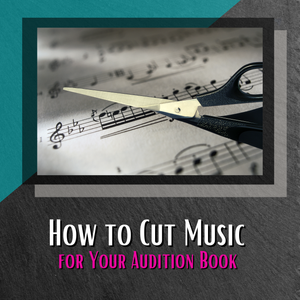 In addition to my performance career, I've been a Musical Director for a few decades. I've seen countless audition books and it always amazes me what singer/actors bring in for their "audition cuts".
In addition to my performance career, I've been a Musical Director for a few decades. I've seen countless audition books and it always amazes me what singer/actors bring in for their "audition cuts".
You can have an amazing voice that's perfect for the job, but if you haven't prepared your audition cut properly, you might as well have stayed home.
But, don't worry. Cutting your music isn't as hard as you think. Back in the day, my friends and I would write all over our music, drawing huge arrows, circling key signatures and scribbling out measures. It ended up looking like a 4-year-old's drawing of "Mommy".
Today, we have so much technology at our fingertips that there's really no excuse to have cuts like that in your book. If you like technology, you can use apps like ForScore or FormulatePRO to cut your music. If you don't feel comfortable doing it yourself, ask a friend or find a service that will cut it for you. (P.S.- Websites like MusicNotes.com even have short or long audition cuts ready and available for purchase.)
Some tips on cutting the music yourself:
- Timing is everything. Rather than counting bars, use a stopwatch. By today's standards a 16-bar cut = 30-45 seconds while a 32-bar cut = 60-90 seconds, depending on tempo.
- Make sure it's a CLEAN COPY. Some hard-to-find songs end up being a copy of a copy of a copy. Make sure that it is readable, and everything is legible. For example, if the bass line is cut off, it's time to find another copy. Purchasing your music on websites like SheetMusicDirect.com and MusicNotes.com make this really easy. (Bonus: You can change the song to your key!)
- A basic way to find a 32, 16 or 8-bar cut: Start at the end of the song and count backwards. Golden Age music is perfect for using this technique because they are usually a combination of verse, bridge and chorus. Contemporary shows can be harder because some are written as a "stream of consciousness" and don't necessarily follow the same pattern. Sometimes the "counting backwards" trick works for contemporary music, but be prepared to make some fancy interior cuts.
- The TIME SIGNATURE & KEY SIGNATURE must be visible.
- Mark the starting point, and the stopping point if it's not obvious.
- A note on long notes: If you are planning on holding a note longer than notated, then make sure to use a fermata (birds-eye) to hold the note, or a caesura (railroad tracks) if you want the pianist to stop before you continue.
- Pages: The final cut of your music should include as few pages as possible. Two pages is a perfect number, but sometimes the cut is longer and you can't avoid it, and that's ok. Just make it as easy on the pianist as you can.
Some final thoughts:
- If you are marking the music by hand, make sure to keep it neat and easy to read.
- Use the punctuation of the lyrics as a guide. Make sure you're singing a complete thought and not starting mid-sentence.
- If you put it into your book, you must know the entire song.
- You should be able to sing every cut in your book from memory when you walk in the room.
- Put your music in a binder.
- The pianist (Musical Director or not) can make or break your audition, so always be kind and courteous. Please and Thank You are always appreciated.
You CAN do this.
(PS- Always remember your book when you leave the room!)
